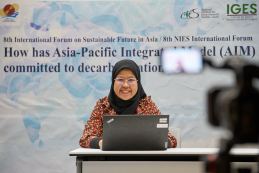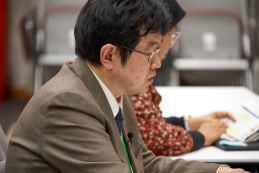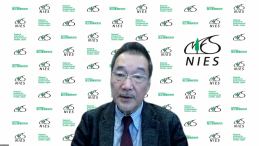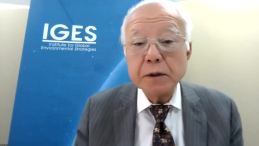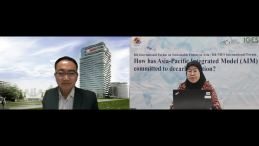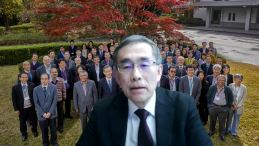Event Report: 8th International Forum on Sustainable Future in Asia / 8th NIES International Forum

Background
This year’s forum, like the previous two years, was held as an online conference using Zoom. The forum, whose theme was the Asia-Pacific Integrated Model (AIM), was co-organized by the Institute for Global Environmental Strategies (IGES), which is collaborating with the National Institute for Environmental Studies (NIES) on the deployment of AIM in Southeast Asia. Research results were presented by researchers involved in policymaking in China, Indonesia, Malaysia, and Thailand, where efforts are being made to reflect the results of AIM analysis in policymaking. The researchers were joined by policymakers in the discussion of expectations and desired improvements for the integrated assessment model.
Keynote Speeches
In Keynote Speech 1 “AIM Initiatives and Experience in Japan,” Toshihiko Masui, forum facilitator and Director of the Social Systems Division of NIES, explained the more than 30-year history of AIM research and used analysis scenarios based on multiple models of AIM to describe the technologies and policies necessary for Japan to realize a decarbonized society in 2050.
In Keynote Speech 2 “Japan’s Support Towards Asia’s Net-Zero Emissions,” Ms. Junko Nishikawa, Director for Sustainable Infrastructure of the Ministry of Environment, Japan, discussed the Ministry and Japan’s involvement in formulating long-term strategies such as the “ASEAN Climate Vision 2050” and explained the practical support provided through the activities of the Japan-ASEAN Integration Fund and the Joint Crediting Mechanism.
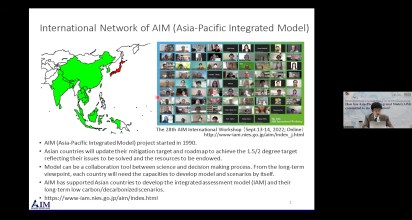
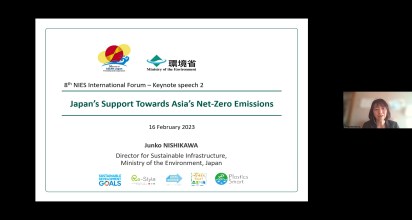
Session 1
Session 1 “Toward the Realization of a Decarbonized Society” was chaired by Tatsuya Hanaoka, Head of the NIES Global Sustainability Integrated Assessment Section. Reports were made by China and Indonesia, which have been developing and using AIM as an assessment tool for evaluating options for the transition to a decarbonized society by conducting various analyses for the realization of decarbonized societies at the national level. Dr. Kejun Jiang of the Energy Research Institute, China, explained the importance of a multi-purpose model that can cover the range of SDGs (climate change mitigation, air quality, water demand, etc.) to achieve China’s target of carbon neutrality in 2060. He introduced an example demonstrating the technical feasibility of and potential for rapid and lower-cost deployment of solar photovoltaic power generation to facilitate energy transition. Dr. Ucok W.R. Siagian of Institut Teknologi Bandung, Indonesia, reported on assumptions for the future and results by sector including examples of electrification on the demand side and increasing renewable energy on the energy supply side. He identified barriers to achieving net zero emissions by 2060, including multi-sector issues, early deployment of electric vehicles, infrastructure development, and funding.
During the Panel Discussion, Mr. Makoto Kato of the Overseas Environmental Cooperation Center, Japan, expressed his expectations for AIM given the importance of science-based decision-making and the growing need for national and local governments to have the ability to implement climate policy, which he discussed based on his experience with the Japan International Cooperation Agency’s low-carbon technology evaluation for Vietnam. The discussion resulted in a request for summaries for policymakers that would aid with the interpretation of modeling results and facilitate stakeholder engagement, recognition of the importance of “design” including policy design and energy transition, and recognition of the need for improving the quality of modeling to gain the confidence of policymakers and stakeholders.
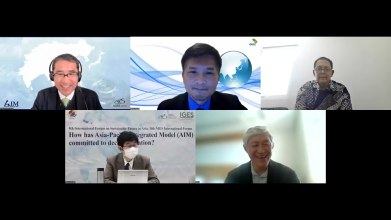
Session 2
Session 2 “AIM as a Policy Support Tool” was chaired by Yosuke Arino, Project Leader, IGES, and Programme Manager for the ASEAN Climate Change Strategic Action Plan. Researchers from Thailand and Malaysia discussed how AIM simulation results were used for climate change mitigation policies. They also discussed expectations for integrated assessments from the perspective of the policymaking process and the contributions and new directions for AIM for decarbonization policy support. Professor Ching Siong Ho of the University of Technology, Malaysia, presented an example demonstrating the use AIM to create Low Carbon Society scenarios for the Iskandar region of Malaysia and described how the process was later disseminated to other cities in Malaysia. Professor Bundit Limmeechokchai of Thammasat University, Thailand, explained how AIM was used to formulate the Thailand Net Zero Emissions 2050 Nationally Determined Contribution (NDC) and the data analysis methods.
Three discussants joined the panel discussion from the standpoint of policymaking. Dr. Vong Sok of the ASEAN Secretariat discussed the characteristics of Southeast Asia’s environmental issues, identified seven priority initiatives for decarbonization, and issued a request for the introduction of AIM to the ASEAN Centre for Climate Change as a key organization driving the initiatives. Mr. BounEua Khamphilavanh of the Ministry of Natural Resources and Environment, Laos, explained the use of the component AIM models in policymaking process in Laos and the benefits of having young researchers participate in AIM training. Ms. Tomoko Ishikawa of IGES and Secretary-General of the Low Carbon Asia Research Network (LoCARNET), a research community centered around ASEAN member nations, explained the use of AIM for science-based policy support with the Vietnamese government. The discussion yielded the following points: (i) both top-down and bottom-up frameworks and participation by diverse actors (e.g., industry, NGOs, citizens, and the young) are essential for promoting science-based policy and policy-based science through the development and deployment of AIM in the Asian region; (ii) inter-city collaborations, including mutual learning by stakeholders at various levels (national to local), are needed to model and fill planning gaps; and (iii) improvements for incorporating new technologies and business models such as LULUCF and AFOLU sector monitoring and Nature-based Solutions need to be explored.
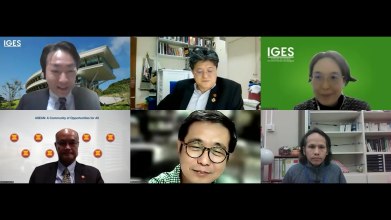
For the Future
This year’s International Forum with the AIM as the theme has been recognized as an event commemorating the 50th Year of ASEAN-Japan Friendship and Cooperation. Thanks to the participation by policymakers in addition to the researchers, who have been the main participants in prior International Forums, we were able to have practical discussions. This was the third year the International Forum was held online; there were many viewers from previous co-organizing institutions and participants from past local venues. It is our hope that we can maintain cooperative relationships while we await the gradual resumption of the face-to-face research exchanges with researchers in foreign countries that were suspended due to the Covid-19 pandemic.
The presentation materials that have been approved by the speakers are posted on the forum's official website.
(https://www.nies.go.jp/i-forum/)
Archived video is available on the official NIES YouTube channel.
(https://youtu.be/e5VsLURW7hc)
*Speakers' titles are as they were at that time.
Photos by Seiji Narita (Public Relations Office, Planning Department)
Photos
